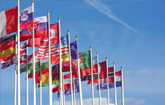First Certified Reference Material for Nanoparticle Size Analysis
WASHINGTON and BRUSSELS, Feb. 18, 2011 /PRNewswire-USNewswire/ --The European Commission's Joint Research Centre (JRC) has developed the world's first certified nanoparticle reference material based on industry-sourced nanoparticles. This new material will help ensure the comparability of measurements worldwide, thereby facilitating trade, ensuring compliance with legislation and enhancing innovation.
Nanotechnology offers a range of benefits over traditional materials and enables the development of innovative applications and products. However, there are often concerns about the safety aspects and to what extent these have been investigated. High-quality measurements are the basis for reliable safety assessments, process improvement, quality control and the development of new nanotechnology applications.
Until now, however, no certified benchmarks incorporating industrial nanoparticles were available. Some synthetic materials were available, but they were not fully representative for "real-life" measurements.
For this reason, the JRC's Institute for Reference Materials and Measurements (IRMM) has produced the world's first certified reference material based on real-world, industry-sourced nanoparticles. The material (ERM-FD100) consists of silica nanoparticles of a nominal diameter of 20 nanometers (nm). Silica nanoparticles are amongst the most widely used nanoparticles at the moment in products such as polish, whiteners and dispersants.
This material provides the basis for reliable hazard assessments and to check that nanomaterials conform to the internationally accepted definition, as laid down in the respective ISO (International Organisation for Standardisation) technical specification. It will enable producers of nanoparticles to monitor production quality over time against a stable reference point, and to assess the impact of process improvements. Furthermore, the certified reference material will contribute to establishing market confidence, demonstrating that nanomaterial products meet the customers' technical specifications.
The release of this certified reference material concludes several years of product development, in which the homogeneity and stability of the material were assessed. Particle size was measured in collaboration with 33 laboratories from 11 different countries in Europe, America and Asia, thus bringing together expert knowledge from across the globe. The material was assessed by different measurement techniques and allows producers of nanoparticles (independent from their final use) to test the size of their particles, including batch-to-batch variability and determine whether or not the particles meet the intended production specifications.
About comparability or measurements
Analytical measurements form the basis for many decisions, not only in a legal sense, but also in industry. Customers set technical specifications and suppliers promise to meet these specifications. With increased international trade, these measurements are usually performed by different laboratories: the supplier tests samples before shipment and the receiver tests them for acceptance. It is crucial that those two measurements are comparable, i.e. that laboratories achieve the same result for their analysis. Otherwise, unnecessary trade disputes emerge or customers refuse to buy from unknown vendors and demand costly testing procedures.
The same applies in the legal arena. Companies must be sure that the results of the official control laboratories are comparable to their own results. Only then can they be sure that compliance with legal limits shown by their own measurements also means compliance for the official control laboratory. Therefore, comparability of measurements is a prerequisite for the unequivocal administration of law for all decisions based on measurements.
There is, however, a third aspect of comparability of results: they must be comparable not only between different laboratories, but also comparable in time for one laboratory. Only if a laboratory is sure that the measurement it carries out today is the same as two years ago, can it make informed decisions. Process improvement relies on such comparisons. Comparability of measurements is therefore a prerequisite for innovation, process improvement and industrial quality control.
About reference materials
There are countless examples in which accurate measurements are crucial, such as hospital blood tests, measuring the size of nanoparticles or checking shipments of foodstuffs for the presence of genetically modified organisms, and they all have a direct impact on the citizens' every day life.
Reference materials play a crucial role behind the scenes, enabling analytical laboratories over the world to carry out tests in a comparable and harmonised manner. They are used by laboratories to calibrate their instruments, to develop reliable testing methods and to perform their regular quality controls.
The JRC's Institute for Reference Materials and Measurements (IRMM) is one of the leading developers and producers of reference materials in the world, particularly in the clinical, food and GMO application areas. It currently provides over 760 reference materials, and distributes around 20,000 units per year.
The JRC's Institute for Reference Materials and Measurements (IRMM)
The mission of the IRMM is to promote a common and reliable European measurement system in support of EU policies. Its prime objective is to build confidence in the comparability of measurements by the production and dissemination of internationally accepted quality assurance tools, including reference materials, validated methods, reference measurements, interlaboratory comparisons and training.
More information: http://irmm.jrc.ec.europa.eu
AAAS session
Measurements as a Cornerstone of Global Trade and Quality of Life
Friday, February 18, 2011: 10:00 AM-11:30 AM (room 159 AB)
Moderator: Stephen A. Wise, National Institute of Standards and Technology (NIST)
Speakers:
Christine M. Pfeiffer, Centers for Disease Control and Prevention
Nutrition: Obtaining Reliable Data To Study the Health Status of the U.S. Population
Hun Young So, Korean Research Institute of Standards and Science
Data for Environmental Monitoring and Protection: Who Can You Trust?
Hendrik Emons, European Commission, JRC Institute for Reference Materials and Measurements
Challenges for Reliable Measurements Across the Boundaries Physics-Chemistry-Biology
SOURCE Delegation of the European Union to the United States
WANT YOUR COMPANY'S NEWS FEATURED ON PRNEWSWIRE.COM?
Newsrooms &
Influencers
Digital Media
Outlets
Journalists
Opted In




Share this article